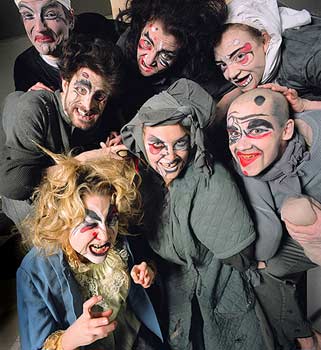|
In the central roles are a group of phenomenal actors, who in spite of limited facial mobility (due to the clown make-ups), convey a range of emotional states, while remaining believable. No easy task, and a credit to not only the skill of the individual actors, but a finely tuned conceptual over-view on the part of the Director and Creator, Michael Kennard.
Our guide throughout the play is Loof Ka, played beautifully by Michaela Washburn. She’s costumed as a classic court jester, or fool (and she’s anything but!). The fool character can be traced back to the earliest modes of theatre, and has an even deeper meaning in various arcane texts (including The Tarot), of ‘The Fool’ or the number “0” as a state of innocence and one-ness with a divine being. Loof Ka introduces the action, and gives the text an element of cohesion.
The Hollow is a classic tale of warring countries. Two Kingdoms, The Rabiccannos (known as the Children of the Devil), and The Lebarians (The Children of God) for half a century have been battling for a secret cave known as ‘The Hollow’ — a space brilliantly created out of burlap by Set Designer Campbell Manning.
There are seven central characters, the medicine-addicted Queen Andmoth (played by the delightful Natalie Breton, as a charmingly befuddled Royal Matriarch); Draziw, the Queen’s grandson — deftly played by Christian Laurin as a sort of morally bereft Jeremy Irons (especially in his smoking jacket); Tifulbeau — The Queen’s Granddaughter, heir to the throne, and all around bubblehead. Christel Bartelse deftly walks that fine line between exaggerated clown behaviours and realism of character — and she does it all with an alarming overbite, an unruly purple wig and a make-up that obscures anything short of the biggest facial gesticulations. Erin Bouvy as Nat is a head servant who is very reminiscent of Mary Wickes, or perhaps Martha Raye. The warmth of her character is palpable, and she establishes a rapport with the audience from her first moment onstage. Nat’s sidekick, Tat, is silent, but deadly. Mark Andrada’s sad clown never loses his dignity, not unlike a latter-day Emmett Kelly. The General, Ramie is as corrupt and addicted to violence as one might expect. When he’s not torturing the prisoners in the dungeon, he’s conspiring with Draziw to put him on the throne. Christopher Sawchyn is brilliant in a difficult role, and his red clown nose doesn’t prevent him from being threatening and repulsive. Stevie Johnston, as the soldier Yarm, uses his actor’s body to convey the military mind-set in the extreme — creating a sort of hyper-goose step.
The Rabbicano prisoners, (who are always objectified as the de-humanizing ‘them’) are played by seven exquisite performers, their costumes incredible distortions of body parts and missing body parts. They wear gray rags, and their make-up reflects illness, poverty and starvation. The prisoners are alternately, thrown in the dungeon, hauled out of the dungeon, starved, forced to perform musical numbers and tortured. There are also some sexual overtones that one might associate with captivity, including a phallus the size of a loaf of “Wonder Bread” attached to the crotch of one of the prisoners, and used on the other prisoners with little discrimination. Also, next to the Leberian royal throne (and for use only by the person sitting on it), is a large glowing orb, startlingly similar to ‘The Orgasmatron’ from Woody Allen’s Sleeper. It seems to be used in conjunction with an interesting prayer motif. Throughout the play, there are definite religious overtones — particularly with the prayer mannerisms of The Lebarians — who seem like a sun worshipping cult, who favour a massive group orgasm. Did I mention that although there are clowns involved — this is definitely a play for grown-ups!!
In the third Act, things take a dark turn. The two factions literally change places. The talented Natalie Breton returns in a second role as Queen Rabiccano — the leader of the Children of the Devil. She is eminently disturbing as the multiple-amputee Queen, rolled onstage by her deformed soldiers in a bizarre conveyance, part shopping cart, part podium. Throughout the play, audience members are encouraged to interact with the performers, and in the third act, a hapless audience member is actually thrown into the dungeon. As a Yankee (and a New Yorker on top of that!), I love to see Canadians let fly in other places besides the hockey rink, and the floor of the Parliament.
A slight criticism of the The Hollow involves the musical accompaniment. I am unsure if we were hearing produced accompaniment tracks, or if there was a rhythm section, or lone pianist behind the curtain. Although music and soundscape Director Michael Barber did an excellent job, I would personally love to see a circus style band of live musicians actually onstage with the performers, or at the very least, some more fully-realized arrangements of the (largely public domain) score.
|


